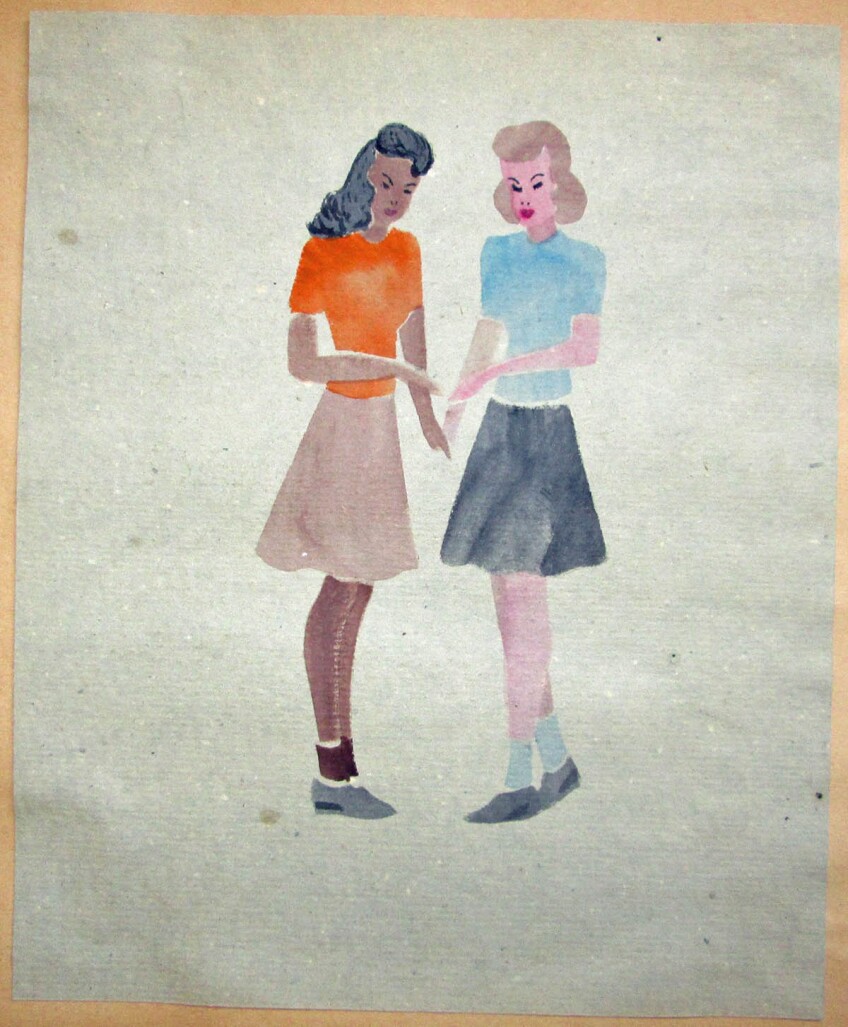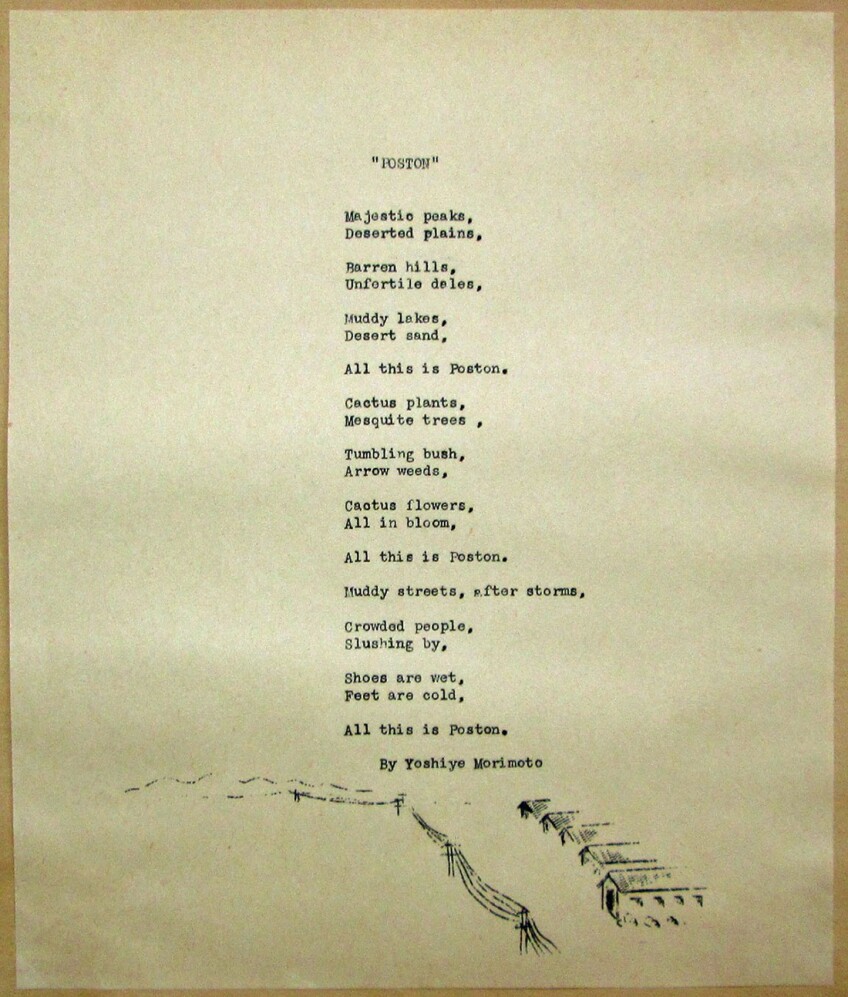Out of the Desert: Internment Camp Art Discovered in Banning

The following article is edited and re-published from California Desert Art, a doorway to the rich bohemian world of early desert artists.
While sorting through decades of items donated to the Banning Public Library — where I worked as a librarian — I found a hand-stitched scrapbook from the 1940s with poems, essays and linoleum prints. There is no record in the library files as to who donated this scrapbook but a loose note inside the cover reads: “Mrs. Nella (sp?) Graham. Compiled by Japanese Students in Concentration Camp in Poston, Arizona, 1942.”

The scrapbook was created by Japanese American students who were incarcerated at the desert internment camp in Poston, Arizona between 1942 and 1945. The camp was east of the Colorado river and just north of Blythe. The internationally acclaimed sculptor Isamu Noguchi voluntarily moved to the camp in 1942 and may have helped to instruct the young artists.
Japanese American designers such as Ruth Asawa, Isamu Noguchi, George Nakashima, Gyo Obata and S. Neil Fujita have made their mark on modern design, but lesser known is how the World War II incarceration had a powerful effect on their lives. See how this period of intense discrimination and hardship changed the course of their lives and careers. Watch "Artbound" S10 E1: Masters of Modern Design: The Art of the Japanese Experience.
The book — titled “Out of the Desert”— includes watercolors and essays describing life in Poston. One page shows photographs of some of the high school students; their classes are credited as chapters of the “American Junior Red Cross.”
The binding of the scrapbook is hand-stitched and the wood-pulp pages are yellowed and disintegrating, however, the poignancy of the art and words expressed by the students survives, clearly documenting an important piece of United States history. A dedication at the beginning reads:
“To Our Fellow-Americans: Deep from out of this lonely desert’s vastness we, the Japanese-American youth, innocent of wrong, firm in our Hope and our Faith, cherishing forever the ideals of our Native Land, striving to build in the wilderness, struggling to build our destiny, extend to you………our Fellowship.”
The Poston internment camp, officially called the Colorado River Relocation Camp, was constructed through the War Relocation Authority (WRA), a U.S. government agency established to accomplish the forced relocation and detention of Japanese Americans during World War II. The site on the Colorado Indian Reservation was selected by the WRA even though the tribal council was opposed to locating the internment camp on reservation land, declaring they did not want to support the injustice of the camps. They were overruled by the Office of Indian Affairs and the U.S. Army.

The WRA was created by Executive Order 9066 and signed by president Roosevelt on March 18, 1942 in response to the Japanese bombing of Pearl Harbor. Between 110,000 and 120,000 Japanese Americans were forced into ten internment camps (officially referred to as “relocation centers”) across the United States.

At 71,000 acres, the Poston camp was the largest of all the camps in the United States. The peak population of the camp was 17,814, making Poston the third-largest city in Arizona at the time. Most of the inmates were California residents who were forced out of their homes, leaving belongings and livelihoods behind. The scrapbook uses the term “evacuees” instead of inmates, although it was clear that the “evacuees” became inmates once they arrived at Poston. Poston was built on the Colorado Indian Reservation in Parker Valley, approximately 15 miles south of Parker and three miles east of the Colorado River, bordering California. It was named after Charles A. Poston, an early pioneer settler in southwest Arizona.
The same fear the American people understandably felt after the attack at Pearl Harbor was also felt by Japanese American families who were taken from their homes, carrying only a few necessities with them and facing an unknown future. They were loaded onto trains, not knowing where they were going or how long they would be away. To survive, most resigned themselves to a fate they couldn’t foresee. As they traveled toward their unknown destination, a concentration camp was being constructed in the Arizona desert.
The harsh climate in southwest Arizona made living conditions barely tolerable, with hot and humid summers sometimes averaging 120 degrees, cold winter nights and frequent dust storms (referred to today in Arizona as “haboobs”). The replicated rows of barracks housing the internees had only wood slats and tar paper for siding.
After leaving Los Angeles on the morning of May 29, 1942, student Nancy Karakane wrote in the scrapbook the following about her arrival in Poston after a 13-hour Santa Fe Railroad trip that would have traveled through Banning: “The heat was terrific! The place was nothing but a 120 degree oven, swarming with dust, dirt, and insects of every type.”
Several internment camp researchers have theorized that some of the internees were temporarily housed at the Banning Road Camp on their way to Poston. Even though this theory is plausible, I’ve never been able to verify it through newspaper microfilm of the time period or Road Camp records.

Within the climate of fear and war after Pearl Harbor, many Americans felt the “relocation” policy was justified. Others opposed the War Relocation Authority and Roosevelt himself was hesitant to implement it, but the overall consensus of the citizens on the West Coast was to err on the side of protecting the population, regardless of any moral dilemmas regarding the incarceration of friends, neighbors and a race of people who were established, patriotic U.S. citizens. During the course of WWII 10 Americans were convicted of spying for Japan. None of those ten were of Japanese ancestry.

In 1988, the U.S. Congress declared that the internment camps were motivated by “race prejudice, war hysteria, and a failure of political leadership.” President Ronald Reagan signed a bill to recompense each surviving internee with a tax-free check for $20,000 and an apology from the U.S. Government.

Many of the writings in the Poston scrapbook express fear that the internment program would become a permanent one. The students worried they wouldn’t be allowed to return home to California and, if allowed to, they wondered if they would be met with hostility and prejudice.
“We cannot lift the veil which conceals the future from our eyes. We do not know what will happen after the war. Everything depends upon the intelligence, the tact, and the wisdom with which we Nisei meet the post-war world……and the tolerance and good will of the post-war world.” – Mary Nakazono, Junior. (The term “Nisei” refers to Japanese Americans born in the United States whose parents were immigrants from Japan)

Betty Meltzer, a local author, educator and historian, visited the Banning Public Library to view the Poston scrapbook. Betty is a Japanese American who has firsthand experiences of WWII from when she lived in Hawaii. After the bombing of Pearl Harbor, her father was taken from her family and imprisoned in an internment camp on the island of Kauai. Betty is a member of both the Japanese American National Museum in Los Angeles and the Riverside chapter of the Japanese American Citizens League.
Meltzer was moved by the artwork and writings of the Poston students who were incarcerated. Their experiences mirrored her own memories of what it was like to be a Japanese American in the early 1940s in the United States. “It is such a heartfelt document of life in an internment camp," she observed. “The students must have literally scrounged for materials in the desert to express what they were feeling and to make art prints."
Thanks to an unknown donor, the scrapbook will now be made available for the public to see and research at the Banning Public Library. A DVD has been created, along with a binder of the printed pages of the scrapbook. The actual scrapbook has been donated to the Japanese American Museum in San Jose.
The scrapbook from Poston is more than a historic document. It is a living testimony to those who endured the darkest of times. Their spirits survived imprisonment and still leave trails in the sands of the desert. Somehow, amazingly, this scrapbook made its way along those desert trails and into the Banning Public Library.
Top Image: Poston students | Courtesy of Bill Bell

